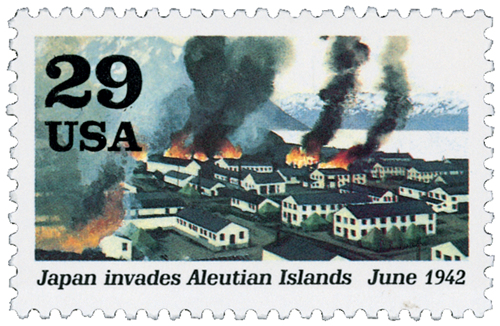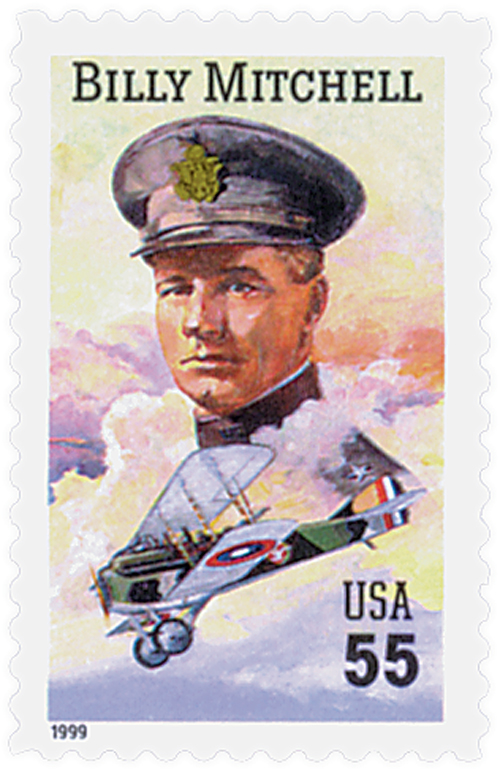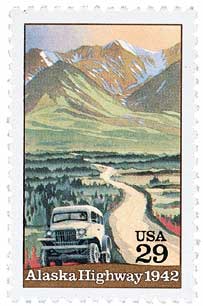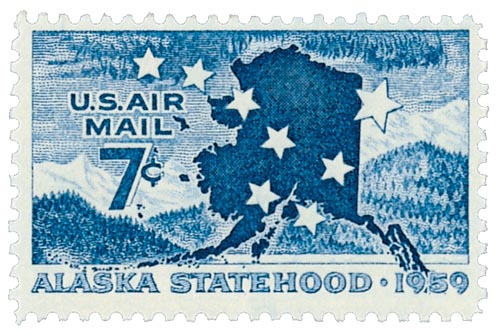
US #2697e
1992 Japan Invades Aleutian Islands, June 1942
- Part of the second Souvenir Sheet issued to commemorate 50th anniversary of World War II
- Sheet contains 10 stamps and a world map.
Stamp Category: Commemorative
Set: 1942: Into ... more
US #2697e
1992 Japan Invades Aleutian Islands, June 1942
- Part of the second Souvenir Sheet issued to commemorate 50th anniversary of World War II
- Sheet contains 10 stamps and a world map.
Stamp Category: Commemorative
Set: 1942: Into the Battle, World War II
Value: 29¢ First Class Mail Rate
First Day of Issue: August 17, 1992
First Day City: Indianapolis, Indiana
Quantity Issued: 12,000,000 stamps
Printed by: Bureau of Engraving and Printing
Printing Method: offset/ intaglio
Format: Sheetlets of 10, arranged in two strips of 5 with a world map between. Offset printing plates of 8 sheetlets (2 across, 4 down). Intaglio printing sleeves of 16 sheetlets (2 across, 8 down)
Perforations: 11
Why the stamp was issued: This stamp is part of a sheetlet issued to commemorate the 50th anniversary of World War II. It was the second in a series of five that were issued over the course of five years.
About the stamp design: There were many topics the USPS wanted to cover when commemorating World War II, but those planning the series didn’t want to issue a large number of stamps. It was decided a sheetlet format would best highlight the main events of the war. In order for all the sheetlets to have a uniform design, the same artist, William Bond, and art director, Howard Paine, were assigned to the entire project.
This stamp shows a military installation in the Aleutian Islands that had recently been bombed by the Japanese. Buildings are still ablaze, with smoke rising from the flames.
Special design details: Though the sheet is very similar to the 1991 issue, there are some small changes. In this sheet, the year 1942 was added to each individual stamp. The previous sheet only had the year on the map, so if the stamps were separated it would have been difficult to identify the year the stamp was commemorating. In addition, an explanation was added to the map which read, “Red areas controlled by enemy.”
First Day City: The First Day of Issue ceremony took place at the national convention of the Veterans of Foreign Wars of the United States, which took place in Indianapolis, Indiana.
About the World War II Series: As the 50th anniversary of World War II was approaching the US Postal Service wanted a series that would recognize the key events of the war and the important contributions America made to the Allied victory. Rather than issue a large number of stamps, the USPS decided to create five sheetlets, each commemorating one year of America’s involvement in the war. Each sheetlet had 10 different stamps arraigned in two horizontal strips of 5. In the center was a world map with Allied and neutral nations in yellow and Axis-controlled areas in red. Notes on the map highlighted key developments that occurred that year. The stamps each featured important events that took place during the year, as well.
History the stamp represents:
The Aleutian Islands were part of the Territory of Alaska. They became the only US incorporated territory to be invaded during the war. The Japanese wanted control of the island chain to prevent US forces from joining with Russia in a future attack. The US feared if the islands fell into Japanese hands, they would be able to carry out an attack on America’s West Coast.The Japanese began their campaign to capture the islands on June 6, 1942. Though they occupied a few of the islands, they faced difficulties in resupplying them and continuing their assault. Efforts on both sides were hampered by poor weather conditions and difficult terrain. It took over a year for the US to recapture the Aleutian Islands.
Aleutian Islands Campaign

One June 3, 1942, Japanese forces kicked off the 14-month Aleutian Islands Campaign. The campaign’s two Japanese invasions were the only ones on US soil during the war.

Before World War II, Japan had gathered information on Alaska’s Aleutian Islands, though none of it was up-to-date by 1942. It was in 1942 that the Japanese decided to attack the Aleutian Islands to prevent the US from launching their own attack across the Northern Pacific. Some historians have also suggested that the invasion of the Aleutian Islands was a diversion to draw the US Pacific Fleet away from the Midway Atoll, which the Japanese attacked on June 4.
The Japanese plan was to launch an air attack on Dutch Harbor followed by an amphibious attack on the island of Adak, 480 miles west. Japanese troops were ordered to destroy any American defenses there, however, the island was undefended. After this, they would conduct landings at Kiska, 240 miles west of Adak, and Attu, 180 miles west of Kiska.
However, US Naval intelligence had cracked the Japanese code and knew of the looming attack by May 21, 1942. At the time, there were about 45,000 US soldiers in Alaska, many of which were air force personnel and engineers – with only about 2,300 infantry troops spread across three bases.

Once American intelligence learned of the impending Japanese attack, Air Force reconnaissance planes were sent out to search for the fleet. On June 2, one of these planes spotted the fleet 800 miles southwest of Dutch Harbor. However, bad weather prevented them from tracking the fleet later in the day.

On June 3, 1942, the Japanese started a two-day bombing of Dutch Harbor. Only about half of the bombers achieved their goals, however, as many got lost in the dark and fog and crashed in the ocean. Seventeen Japanese planes reached the base, but were immediately subjected to intense anti-aircraft fire and attacks from Air Force fighters. The Japanese pilots were surprised by the American response and quickly dropped their bombs and rushed back to their carriers, inflicting minimal damage. The Japanese returned the next day better prepared and inflicted more damage to the oil storage tanks, hospital, and beached barracks ship.

Bad weather made it difficult for American pilots to sink the Japanese ships as they were ordered. However, the weather also forced the Japanese to cancel their planned invasion of Adak. However, they proceeded with their attacks on Kiska on June 6 and Attu on June 7. These invasions shocked America. Many in America feared that if the Japanese retained control of the Aleutian Islands, they could launch attacks on the US West Coast.
The US Air Force set up a base on Adak Island from which to bomb the Japanese on Kiska. Navy ships and submarines also patrolled the area, engaging the Japanese fleet on several occasions. In March 1943, American forces successfully eliminated the Japanese supply convoys in the Battle of the Komandorski Islands. In May 1943, American infantry launched Operation Landcrab, to recapture Attu. The grisly battle saw one of the largest banzai charges of the Pacific campaign, but ultimately the Japanese force there was decimated.

In August 1943, a combined force of 34,426 US and Canadian troops landed on Kiska, after a three-week barrage. However, they found the island had been abandoned two weeks earlier and the campaign was declared over by August 15. The campaign has been called the “Forgotten Battle” because it was overshadowed by several other battles. Several areas from the battle were later placed on the National Register of Historic Places or declared National Historic Landmarks.
Find out more from the Aleutian Islands World War II National Historic Area website.














